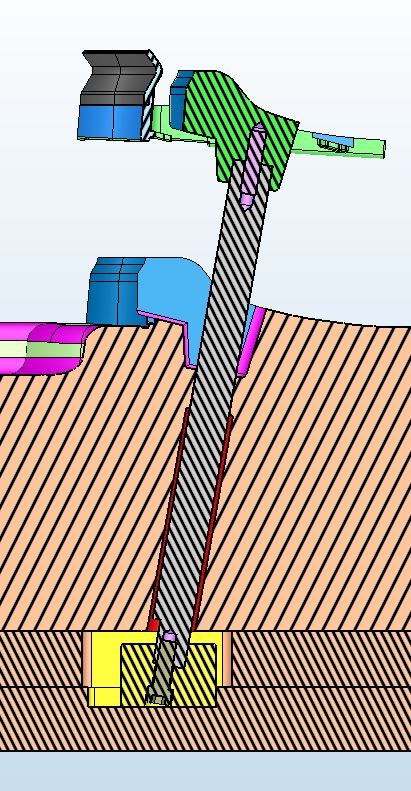The Designer's Edge: Let's Talk Lifters
Today Randy is moving to the topic of lifters in the hopes of providing an understanding of these components and their impact on tool maintenance, repair and molding.

Shows a lifter in the eject position releasing the undercut on the molded part.
Today I’m moving to the topic of lifters in the hopes of providing an understanding of these components and their impact on tool maintenance, repair and molding.
A lifter is a component that travels with the ejection and moves on an angle to slide/pull the cavity steel away from undercuts or details not in the die draw, and where slides or other mechanics are not an option.
There are many aspects of lifters to cover, including design considerations, materials used, wear surfaces, buddy/helper pins, deflection, round versus square, part sticking issues, fitting/spotting and timing/pre-load. In this series, I will discuss the reasons lifters are used, angles/travel and a couple design considerations in relation to the angle/travel.
I manage thousands of PMs and repairs each year, which consist of a wide variety of mold designs from all over the world running various plastic materials. This experience has helped me gain knowledge about tool design and how it can impact the manufacturing environment, namely failures and processing issues.
I use the phrase “red flags and sirens” to label concerns or issues, and the component that jumps out the most when it comes to tool maintenance and repair concerns is the lifter. Typically, those involved with tool maintenance prefer slides as an option for tool designs, but they are not an option when lifters are used. This is important to mention because there have been times when slides could have been used instead of lifers. However, in most cases lifters are used.They are a necessity and have advantages when it comes to real estate versus slides.
The design, angle and materials used with lifters can have a big impact on the tool and cause failures when running the mold. I have had many tools run flawlessly with zero lifter issues over millions of cycles, but with other tools I’ve experienced nightmares. The lifter stands out as the one component in a mold design as needing a little extra attention with regards to angles, timing, shut-offs and unsupported length.
Some of you may be saying that you don’t have issues with lifters, but I would suspect you are running parts with lessons learned involved or using low-draft lifters with shallow undercuts. I use "lessons learned" meaning from the knowledge gain from previous failures with design.
Next month, I will dive into lifter angles, travel and unsupported length.














